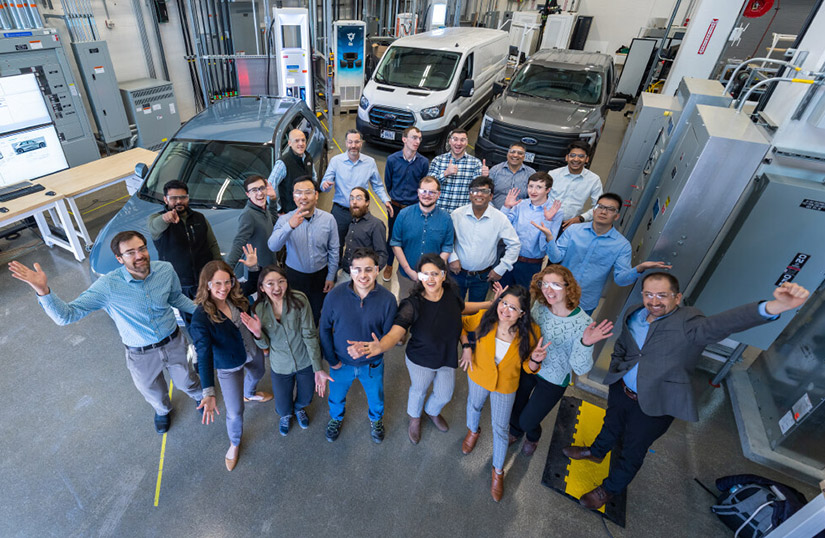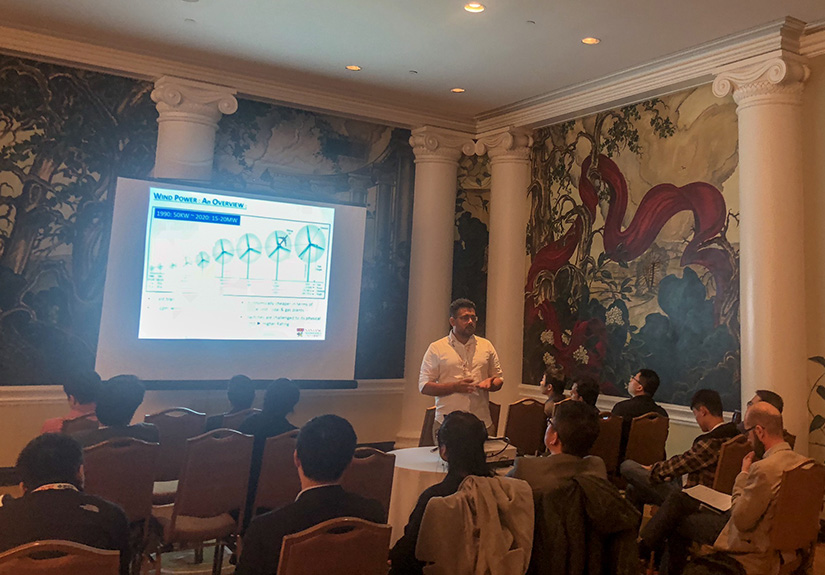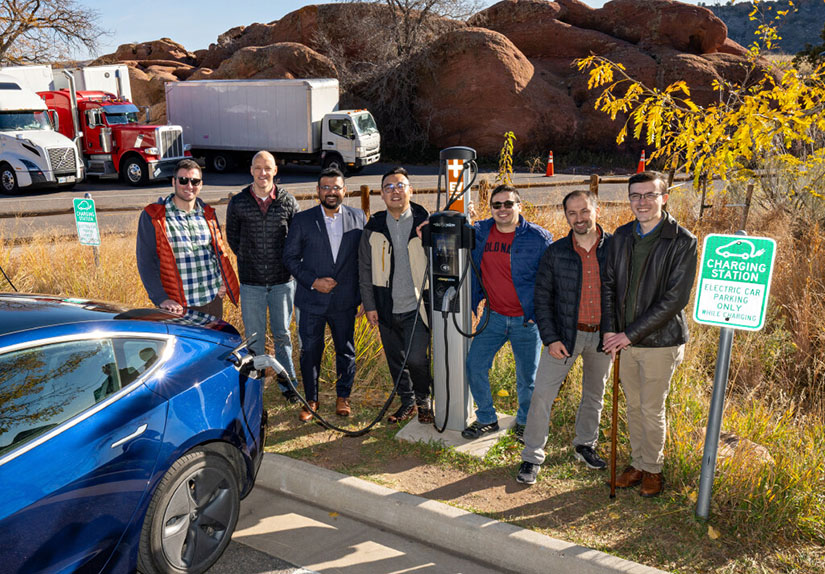Researcher Shafquat Khan Elevated to Institute for Electrical and Electronics Engineers Senior Member
A Passion for Cricket and Cars Inspired Khan’s Career in Renewable Energy
Growing up in Bangladesh, Shafquat Khan was most interested in two things: cricket and cars. A future career in renewable energy was far from his mind.
“’How do so many moving parts work in sync and make a car move?’ That was my driving question,” Khan recalled. “I was interested in vehicle electronics, and I stayed far away from clean energy.”
That changed when Bangladesh got serious about the leading cause of air pollution in Dhaka, its capital city: two-stroke engine “baby-taxis,” or motorized rickshaws, which ran almost exclusively on gasoline. In 2003, the Bangladesh government banned two-stroke engines from the capital and allowed only cleaner-burning compressed natural gas (CNG)-fueled engines to operate. The mandate created measurable improvements in air quality—and that cleaner air had an impact on Khan.
“I saw that one small decision could made an impact, literally, on a person’s ability to breathe,” Khan said. “Then I realized that a researcher could make this kind of impact on a global scale.”
It led him to apply for Ph.D. programs in renewable energy areas.
Now, Khan is a researcher within the National Renewable Energy Laboratory’s (NREL’s) Center for Integrated Mobility Sciences and has been named a senior member of the Institute of Electrical and Electronics Engineers (IEEE). While IEEE boasts more than 450,000 members, just 10% of them are named senior members. Khan’s elevation recognizes his contributions to advancing safe, reliable, high-power electric vehicle (EV) charging infrastructure.

Shafquat Khan (middle row, far left) is an EV charging infrastructure researcher with NREL’s
Advanced Vehicles and Charging Infrastructure group. Photo by Werner Slocum, NREL
A New Approach to EV Charging
Khan’s research blends his love of power electronics with a passion for clean energy.
As a researcher within the Charging Hardware for Advanced Research & Grid Impact Evaluations (CHARGE) team, he focuses on the design and development of high-power direct-current (DC) electricity distribution systems for EV charging infrastructure.
Put simply, the electricity running through your walls is normally in the form of alternating current (AC) power. But most of your devices—your phone, laptop, and even your EV—require DC power to charge. Each time energy needs to be converted from AC to DC and back again, some of that energy is wasted.
Rather than converting AC to DC electricity to charge EVs, Khan’s research focuses on designing and building DC “microgrids”: small, highly localized DC electric power systems. The DC-only charging sites Khan and his team design allow for seamless integration of renewable energy from solar panels and on-site energy storage systems. Using these backup energy storage systems, and with added smart charge management strategies, they can also avoid “surge pricing” that incurs when many EVs are plugged into chargers at once, resulting in a spike in energy demand. Together, these strategies can allow for the most cost-effective charging possible.
Khan is specifically interested in improving the ability of these sites to optimize electricity usage and allow for high-power EV charging for large fleets. For instance, through the Athena Zero-Emissions Vehicles (Athena ZEV) project, he is working to help Dallas Fort Worth International Airport to determine the EV charging infrastructure needed to support fully electric rental car fleets. Through the High-Power Electric Vehicle Charging Hub Integration Platform (eCHIP) and Advanced Research on Integrated Energy Systems (ARIES) projects, he is working to refine DC distribution systems so the EV chargers connected to them have smaller footprints and higher efficiency.
“We are directly addressing the global challenges in transportation electrification with this work,” Khan said. “We work with fleet operators, charging site owners, and partners who are interested in large-scale fleet electrification, and we have the research resources to make significant contributions to their plans.
“We can find out what gaps and challenges they have in adopting EVs,” he continued. “We can directly increase the interoperability, safety, and reliability of technologies through our research. And then we can demonstrate them in person, at scale. This is of critical importance."

One of his proudest moments has been contributing to NREL’s work with USAID to provide technical assistance to Bangladesh. Through the Reinforcing Advanced Energy Systems project, Khan is helping to develop a strategic blueprint that charts a cost-effective path to fleet electrification in one of Bangladesh’s economic zones.
Ironically, Khan first became aware of NREL during his Ph.D. program, when he found one of the laboratory’s publications about Bangladesh’s wind power assessment. Now, he is contributing original research to the partnership.
“Of all my work, this feels special,” Khan said. “It’s an opportunity to give something back to my home country."
A ‘Very Interesting Matrix’ For Success
Khan’s recent recognition from IEEE has given him a chance to reflect on the years he has spent engaged in the professional society.
“All students in electrical engineering and power electronics have a special relationship to IEEE,” Khan said. He started attending IEEE events during his undergraduate education in Bangladesh and then became more involved in their conferences, lectures, and trainings during his Ph.D. program at Nanyang Technological University in Singapore. Now, he is a member of the IEEE Denver Section, which is home to more than 3,000 engineers and technical professionals.

As far as his elevation to an IEEE senior member, Khan gives much of the credit to his former team lead, Mithat John Kisacikoglu. He also mentions Kalpesh Chaudhari, a former NREL employee who played a vital role in inspiring him to seek excellence not only at NREL but also in IEEE.
“John materialized this,” Khan said. “He kept pushing it as a target for me, and he was on me all the time. ‘Did you apply?’ ‘What’s the status?’ ‘Do you need more recommendations?’ He was always backing me up. And Kalpesh, he has always been a friend, an inspiration.”
Khan’s hope is to inspire more current IEEE members to come to a point in their career where they, too, can become senior members.
“One of the great things about IEEE membership is that you can only advance by contributing more, not in terms of publications, but also by contributing to the advancement of your field,” Khan said. “It’s a very interesting and inspiring matrix.”
Learn more about NREL's sustainable transportation and mobility research and its specific focus on commercial vehicle decarbonization. And sign up for NREL's quarterly transportation and mobility research newsletter, Sustainable Mobility Matters, to stay current on the latest news.
Last Updated May 28, 2025
